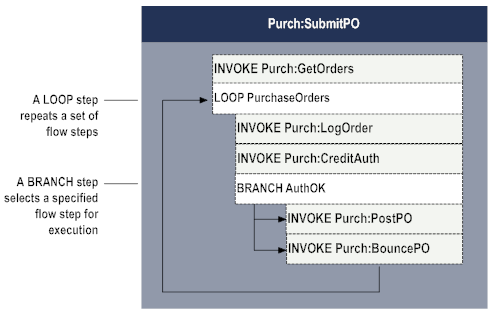
Invocation Steps | |
 INVOKE INVOKE | Executes a specified service. For more information about this step, see
The INVOKE Step. |
Data-Handling Steps | |
 MAP MAP | Performs specified editing operations on the pipeline (such as mapping variables in the pipeline, adding variables to the pipeline, and dropping variables from the pipeline). A MAP step can also contain transformers which are service invocations. For more information about this step, see
The MAP Step. |
Control Steps | |
 BRANCH BRANCH | Executes a specified flow step based on the value of a specified variable in the pipeline. For more information about this step, see
The BRANCH Step. |
 LOOP LOOP | Executes a set of flow steps once for each element in a specified array. For more information about this step, see
The LOOP Step. |
 REPEAT REPEAT | Re-executes a set of flow steps up to a specified number of times based on the successful or non-successful completion of the set. For more information about this step, see
The REPEAT Step. |
 SEQUENCE SEQUENCE | Groups a set of flow steps into a series. The SEQUENCE step is implicit in most flow services (that is, the steps in a flow service are treated as a series). However, at times it is necessary to explicitly group a subset of flow steps using SEQUENCE so that they can be treated as a unit. For more information about this flow step, see
The SEQUENCE Step. |
 EXIT EXIT | Controls the execution of a flow step (for example, abort an entire flow service from within a series of deeply nested steps, throw an exception without writing a Java service, or exit a LOOP or REPEAT without throwing an exception). For more information about this step, see
The EXIT Step. |
 TRY TRY | Executes a set of flow steps for which you want to provide failure handling and/or cleanup in a CATCH or FINALLY step. For more information about this step, see
About the TRY, CATCH, and FINALLY
Steps. |
 CATCH CATCH | Executes a set of flow steps that handle a failure that occurred during execution of a TRY step. For more information about this step, see
About the TRY, CATCH, and FINALLY
Steps. |
 FINALLY FINALLY | Executes a set of flow steps that typically perform some type of clean up after a TRY step or TRY and CATCH steps execute. For more information about this step, see
About the TRY, CATCH, and FINALLY
Steps. |